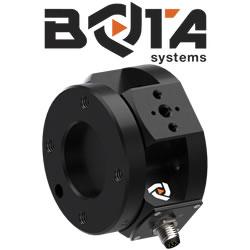Kane Robotics Unveils Cutting-Edge AI for Collaborative Robots
GRIT Vision System sets new standards in manufacturing with enhanced robotic weld grinding
(AUSTIN, TEXAS - Jan. 29, 2024) - Kane Robotics (Kane) has harnessed the transformative
uneven surfaces and enabling its collaborative robot (cobot) to make real-time adjustments in
material removal operations.
"Thanks to AI, we can now teach a cobot to flexibly respond to changes in surfaces based on
what it ‘sees' through a camera attachment," says Arlo Caine, Kane's robotics engineer who
spearheaded the GRIT Vision System. "The cobot world hasn't seen this before."
The new GRIT Vision System expertly handles tasks such as sanding, grinding and finishing in
the manufacturing process, thanks to a high-speed camera and AI-driven computer vision
integrated with Kane's GRITTM cobot solution.
A human operator sets up the cobot and attaches the necessary tools for the weld-grinding
process, then monitors and adjusts the process through a live custom interface. Next, artificial
intelligence takes over. Using the camera, the vision system "sees" uneven surfaces on a weld
or seam. Thanks to rapidly learning AI, the system alerts the cobot's robotic arm and steers it
accordingly.
GRIT Vision System was first introduced at the Paul Mueller Company, a Missouri-based global
manufacturer of stainless steel tanks and equipment, which needed a solution for seamlessly
grinding welds on large steel tanks used in the dairy, food, brewery, beverage, pure water and
pharmaceutical industries. GRIT's AI software performs live object detection, ensuring accurate
tracking even as the weld seam disappears during rotation. When faced with imperfect welds,
the system proved it could be taught to detect variations and refine its grinding accuracy.
At the Paul Mueller Company, the cobot is perfectly collaborative. The GRITST cobot does the
tedious and strenuous work of holding the grinder. The vision system manages the tiring task of
tracking large seams for long periods.
Finally, a human operator sets and adjusts the force level most suitable to the chosen abrasive,
grinding speed and number of grind passes to achieve the required finish.
While originally developed for weld grinding, the groundbreaking GRIT Vision System is
compatible with various robotic components and customizable for diverse applications, from
polishing aerospace parts to sanding furniture.
"The GRIT Vision System is a breakout for collaborative robotics," said Kane CEO John Spruce.
"Kane was among the first to successfully integrate robots, tools, cameras and AI software into
a cohesive product. Today, that means more efficient, precise and safe material removal in
manufacturing. The future possibilities are limitless."
About Kane Robotics
Kane Robotics was founded in 2019 by industry experts determined to simplify material removal
processes through automation. Its GRITTM system was the first collaborative robot (cobot)
designed for sanding, grinding, and finishing, and today, manufacturers of all sizes and types
employ the solutions. The turnkey, easy-to-operate cobots are configurable for specific material
removal tasks and include an AI-powered computer vision system for more advanced material
removal in weld grinding. For more on how Kane's compact, mobile and affordable solutions can
improve productivity by 50 percent or more, visit http://kanerobotics.com.
Featured Product

Bota Systems - The SensONE 6-axis force torque sensor for robots
Our Bota Systems force torque sensors, like the SensONE, are designed for collaborative and industrial robots. It enables human machine interaction, provides force, vision and inertia data and offers "plug and work" foll all platforms. The compact design is dustproof and water-resistant. The ISO 9409-1-50-4-M6 mounting flange makes integrating the SensONE sensor with robots extremely easy.
No adapter is needed, only fasteners! The SensONE sensor is a one of its kind product and the best solution for force feedback applications and collaborative robots at its price. The SensONE is available in two communication options and includes software integration with TwinCAT, ROS, LabVIEW and MATLAB®.
